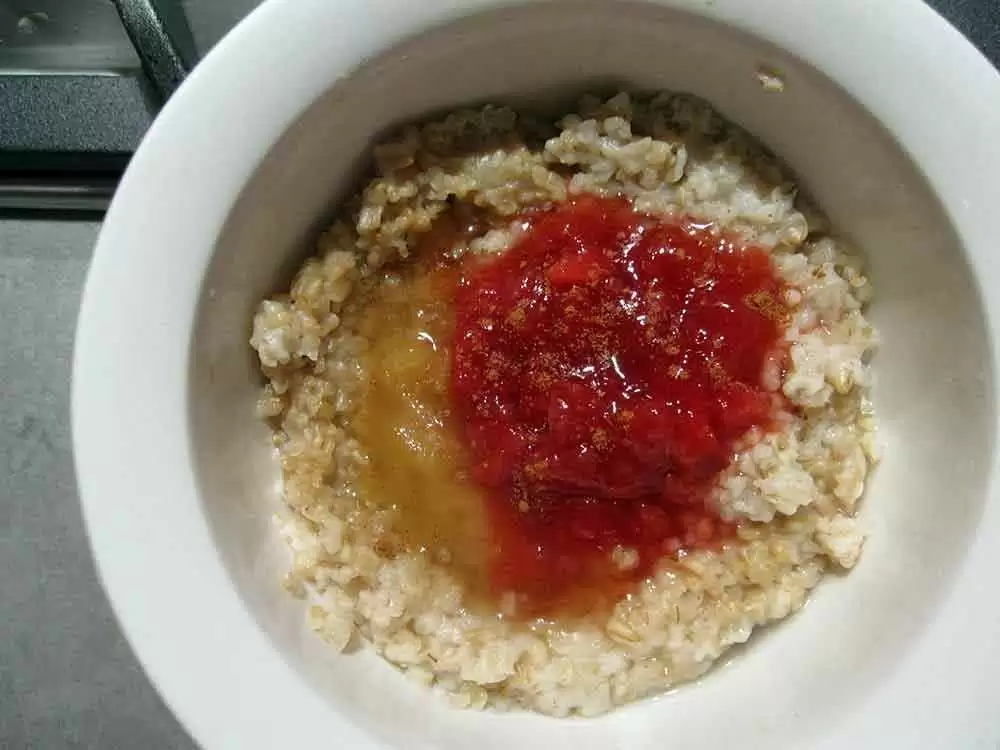
Celiac.com 03/19/2022 - The world is changing. Many teenagers know more about nutrition than their parents. Adults are being taught that they can control diseases and physical conditions through proper diet. Exercise spas and diet centers are springing up everywhere. New words like ‘trans fats’ and ‘hydrogenated’ are becoming a part of our everyday vocabulary. Despite all of this, over 50% of American adults are obese, proving that we still love to consume our deep fried French fries and hot fudge sundaes!
Forget weight-loss diets. Instead, concentrate on eating healthy, every day, for the rest of your life.
Celiac.com Sponsor (A12):
Initially, it will be challenging to alter preparation methods and eating habits. But once you are committed to change, you will be amazed at how good you feel and how much your energy level has increased. It’s not easy, however, to take these steps when everyone in the family is juggling busy schedules. Kids, especially younger ones, will eat mostly what’s available at home. That’s why it is important to control the supply lines—the foods that you serve for meals and have on hand for snacks. Here are ten strategies that you should incorporate into your routine:
Have a Healthy Refrigerator
Make sure your refrigerator is stocked with more low-fat, high-fiber and low sugar foods than other types. Hide desserts behind the carrot sticks and cut-up broccoli with the low-fat onion dip, or put the dessert in the back of the bottom shelf, reserving the front of the shelves for the healthier snacks. Fill your meat bin with lean lunch meats like turkey breast and lean roast beef. Put a plate full of peanut butter-stuffed (the non-hydrogenated type of peanut butter!) celery covered with plastic wrap in the refrigerator for a quick and healthy snack. Prepare a bowl of cleaned strawberries or grapes as well.
Make Wise Use of Your Freezer
On the nights when there isn’t time to cook, have homemade, nutritious, pre-prepared dinners handy in your freezer. Buy 100% fruit juice, add some water, and then pour it into small cups or plastic glasses to make homemade slushies. When you make bread, make a double batch and freeze half of the dough for another time.
Prepare the Pantry
Replace the sugary cereals with wholesome ones. At breakfast, add sliced bananas, berries, nuts, raisins and/or dried cranberries for extra taste and nutrition. Have canned or dried beans on hand to add to soups, salads, rice, and casseroles. Replace white rice with brown rice. Replace corn or rice pasta with quinoa. If your kids love potato chips, prepare or buy baked sweet potato chips.
Make Healthy Food Appealing
Toss a few mini M&M’s into trail mix. Add sautéed almonds or mushrooms to the green beans. Stir fruits, nuts or all-fruit preserves into the low-fat yogurt then add a few baking sprinkles on top. Place a container of chocolate syrup next to the skim milk so the kids will be encouraged to get their calcium by making quick hot chocolate or chocolate milk. Make fruits fun to eat by arranging different fruits (apple slices, raisins, bananas, dried cranberries) into a face or other artistic form. Cut faces or designs out of cheese slices or use a cookie cutter to cut fun-shaped sandwiches.
Cook Healthier
Add chopped, fresh garlic to salad dressing, sautéed foods, stews, and everything else. Add shredded cabbage or spinach to meatloaf, stews and soups. Stir a few tablespoons of ground flax seed—it has no distinguishable taste—into everything, including cereals, stuffed peppers, casserole toppings, and even apple pie. Spray pans with gluten-free nonstick spray instead of using butter or oil when cooking scrambled eggs and stir-fries. Avoid deep-fried foods; choose broiling, grilling, roasting, and steaming instead. Shred hard-boiled egg whites into salads, sandwich fillings and casseroles. Add water-packed gluten-free tuna to casseroles, salads, and in wraps. There are hundreds of ways to prepare salmon—experiment with some of them. Eat ‘meatless’ at least once a week with foods like chili with beans, bean tortillas, zucchini quiche, vegetable paella, or eggplant Parmesan Parmigiana. Add fruits to your salads, including dried cranberries, raisins, pears, apples, oranges, kiwi, pineapple or melons. Add something to rice, such as sautéed chopped vegetables, cooked lentils, red or black beans, or even chopped shrimp. Serve marinated broiled tomatoes as a side dish or chop and serve as Bruschetta. Add veggies to sandwiches, such as watercress, spinach, sliced peppers, onions, cucumbers, zucchini or and radishes. Serve a baked sweet potato instead of a white potato. Serve polenta or corn bread instead of biscuits. Use more herbs and decrease salt. Forget the cupcakes; prepare baked apples for dessert. When you bake bread or muffins, sneak in some fruit or vegetables— shredded carrots, berries, apples, pears, zucchini, crushed pineapple packed in its own juice or mashed banana.
Drink Up
Have bottles of water in the refrigerator. Send them with your kids when they go to soccer practice; take them in the car anytime you leave home. Switch from coffee to unsweetened green tea. Instead of sodas, have a pitcher of iced tea in the refrigerator—did you know that there are up to 12 teaspoons of sugar in your average can of cola? Puree fresh fruits with juice for a nutritious smoothie.
Eat As a Family
Due to busy lifestyles, this is not always possible. But meals will be more balanced and more nutritious when everyone sits down together at the table instead of grabbing something from the refrigerator on the run. A new study in the Journal of Public Health Nutrition showed that what parents consumed was the biggest influence on their children’s diets. Your message will get muddled if you give your kids carrot sticks with their sandwich while you eat potato chips with yours. Set a good example for the whole family’s sake.
Shrink the Size
Cut portions of meat to three or four ounces, then serve it with a variety of beans and vegetables as side dishes to fill up your hungry crew. Eat half of a sandwich for lunch with a small tossed salad, instead of a whole sandwich. Eat half of a restaurant entrée, bringing the rest home for dinner tomorrow. Read labels—did you know that the calorie count given for one serving of pasta is usually for only one cup of cooked pasta? Use a smaller dinner dish so that no one will notice that the food portions are less.
Stay Away from the Inside Aisles
When you grocery shop, fill your cart from the aisles around the outside perimeter of the store— this is where the fresh foods are kept. Use buttermilk for baking. Originally, buttermilk was the liquid remaining after cream was churned into butter, but today it is made by adding lactic-producing bacteria and nonfat milk solids to pasteurized milk. Fresh vegetables are more nutritious than frozen—frozen vegetables are more nutritious than canned. Lean cuts of pork compare favorably with skinless chicken, so use pork tenderloin and boneless loin chops for variety. Chicken thighs are higher in fat and calories than breasts, but if you remove the skin and any excess fat, economical thighs are healthy because they provide 25 percent more iron and more than double the zinc as the same portion of breast meat.
Let the Family Participate
Picky eaters are more likely to eat a new food if they have helped in its selection and preparation. While at the store, ask your child to choose a new vegetable or fruit, from two to three choices, for a weekly “try-a-new-food” night. If you bribe your child to eat his spinach so that he can have a yummy dessert, you inadvertently reinforce the idea that sweets are better than nutritious food. Instead of rewarding your children with food, reward them with attention—hugs, kisses, and smiles—and playful activities. Three year olds can help scrub and rinse fruits and vegetables, stir ingredients in a bowl, shake liquids in a covered container, and knead and shape smaller pieces of yeast dough. Four years olds can peel oranges and hard cooked eggs, mash bananas with a fork, mix meatloaf ingredients, and use their kid-safe scissors to cut parsley or green onions. By the time they are five years old, they can help with measuring ingredients and use a whisk.
Gluten-Free Apricot Almond Bites
Sometimes, even when you are trying to eat healthy, your family craves something sweet. The recipe below is from Connie’s ‘Wheat-free Gluten-free Recipes for Special Diets’ cookbook. This recipe is dairy-free, egg-free, peanut-free, tree nut-free, soy-free, yeast-free and approved for those on a diabetic, low sodium, vegetarian and/or vegan diet.
Ingredients:
- 1 cup almond flour
- 1 1⁄2 tablespoons cornstarch
- 1⁄4 cup sugar
- 1 1⁄2 teaspoons egg replacer
- 1⁄4 teaspoon baking powder
- 1 teaspoon vanilla
- 1⁄2 teaspoon almond flavoring
- 4 tablespoons apricot nectar
- 1⁄2 cup dried apricots, minced
- 1⁄4 cup dried cranberries
Directions:
In a large bowl, stir together first 5 ingredients. With a rubber spatula, stir in the vanilla, almond flavoring and apricot nectar till blended. Stir in dried fruits. Drop by scant teaspoonfuls onto a greased baking sheet. Set sheet in the refrigerator for 1 hour to set. Preheat oven to 350F. Bake cookies for 10 minutes until tops are just barely browned (Do not over bake!). Let cookies set on cookie sheet for 2 minutes before removing to a wire rack to cool. Yield: 36 cookies.
Calories: 13. Total fat: 0.2g; Saturated fat: 0.1g; Cholesterol: 0mg; Sodium: 0mg; Carbohydrates: 2.4g; Fiber: 0.2g; Sugar: 1.1g; Protein: 0.2g











Recommended Comments
There are no comments to display.
Create an account or sign in to comment
You need to be a member in order to leave a comment
Create an account
Sign up for a new account in our community. It's easy!
Register a new accountSign in
Already have an account? Sign in here.
Sign In Now